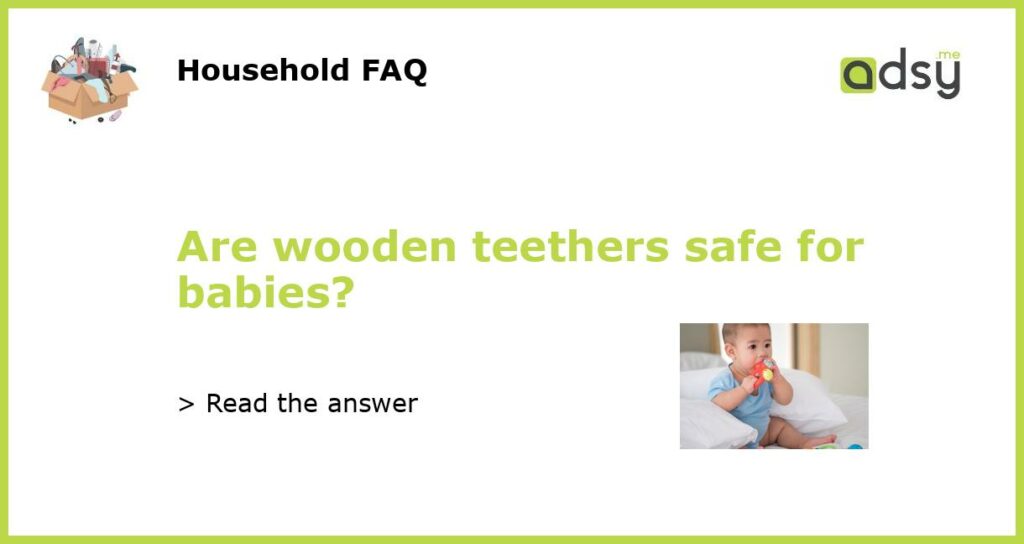Are Wooden Teethers Safe for Babies?
When it comes to choosing toys and teethers for their little ones, parents are often concerned about safety. One popular option for teething babies is wooden teethers. But are wooden teethers really safe for babies? Let’s take a closer look at the pros and cons of wooden teethers to help you make an informed decision for your little one.
The Benefits of Wooden Teethers
Wooden teethers have been used for centuries and have a number of benefits that make them a popular choice for parents. Here are some of the advantages of wooden teethers:
1. Natural and Chemical-Free: Wooden teethers are typically made from natural wood, which means they are free from harmful chemicals such as BPA, phthalates, and PVC, commonly found in plastic toys. This makes them a safe option for babies to chew on.
2. Durable: Wooden teethers are generally more durable than their plastic counterparts. Babies can be quite rough on their toys, and wooden teethers are often able to withstand the wear and tear better than plastic toys.
3. Sensory Stimulation: Wooden teethers can provide babies with a different sensory experience compared to other materials. The natural texture and scent of wood can be soothing for babies who are teething.
4. Eco-Friendly: Many parents are concerned about the impact that plastic toys have on the environment. Wooden teethers, on the other hand, are biodegradable and do not contribute to the plastic waste problem. Choosing wooden teethers can be a more sustainable choice for the planet.
Potential Risks of Wooden Teethers
While there are many benefits to using wooden teethers, there are also some potential risks that parents should be aware of:
1. Splintering: One of the main concerns with wooden teethers is the risk of splintering. Poorly made or low-quality wooden teethers may have splinters that can be harmful if they get into a baby’s mouth. It is important to choose wooden teethers that are smooth and free from any rough edges or splinters.
2. Choking Hazard: Just like with any teething toy, there is always a risk of choking. It is important to choose wooden teethers that are large enough to prevent babies from putting the entire teether in their mouth and to regularly check for any signs of wear or damage that could cause small pieces to break off.
3. Hygiene Concerns: Wooden teethers, unlike their plastic counterparts, cannot be easily sterilized or cleaned in a dishwasher. This can make it more challenging to keep wooden teethers clean and free from bacteria. However, regular washing with mild soap and water should be sufficient to keep wooden teethers clean.
Tips for Using Wooden Teethers Safely
If you decide to use wooden teethers for your baby, here are some tips to ensure their safety:
1. Choose High-Quality Teethers: Look for wooden teethers that are made from high-quality materials and have been tested for safety. Avoid teething toys that have rough edges or signs of splintering.
2. Supervise Your Baby: Whenever your baby is using a teether, it is important to supervise them to prevent any accidents or choking hazards. Never leave your baby alone with a teething toy.
3. Regularly Inspect the Teether: Check the teether regularly for any signs of wear or damage. If you notice splintering or any small pieces breaking off, it is time to replace the teether to ensure your baby’s safety.
4. Keep it Clean: As mentioned earlier, wooden teethers cannot be easily sterilized, but regular washing with mild soap and water is sufficient to keep them clean. Avoid using harsh chemicals or cleaning agents on wooden teethers.
Wooden teethers can be a safe and natural option for babies. The benefits of wooden teethers, such as being natural, durable, and eco-friendly, make them a popular choice for many parents. However, it is important to be aware of the potential risks, such as splintering and choking hazards. By choosing high-quality teethers, supervising your baby, regularly inspecting the teether, and keeping it clean, you can ensure the safety of your little one while using wooden teethers.






